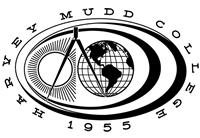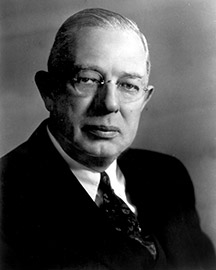Two years later, in 1957, when the space race made technical education a priority in the United States, the College opened its doors. The founders’ vision—to attract the nation’s brightest students and offer them a rigorous scientific and technological education coupled with a strong curricular emphasis in the humanities and social sciences—has been successfully realized and expanded. In 1963 the college initiated the nationally recognized Clinic Program, which allows student teams to solve problems posed by sponsoring industry, government and nonprofit organizations. The emphasis on undergraduate research for all students has led to Harvey Mudd graduates earning PhD degrees in science and engineering at one of the highest rates in the nation.
Harvey Mudd College Opens
Harvey Mudd College opened in September of 1957, less than a month before Sputnik I launched the Space Age. Forty-eight students and seven faculty who shared the dream of starting a technical college that would emphasize the humanistic aspects of technology were on hand when the school opened its doors. Nuclear physicist Joseph B. Platt served the fledgling institution as its first president, and new courses and a new curriculum were formulated under a grant from the Carnegie Corp.The founding faculty of Harvey Mudd College were:
- Graydon Bell, assistant professor of physics
- J. Arthur Campbell, professor of chemistry
- William Davenport, professor of humanities
- Robert James, professor of mathematics
- Duane Roller, professor of physics
- Roy A. Whiteker, assistant professor of chemistry
- George Wickes, assistant professor of humanities
The First Students
The first classes at Harvey Mudd College consisted of one (almost) completed dorm and borrowed classrooms and equipment. During the early years, most faculty members readily took on administrative responsibilities in addition to their teaching jobs. Some classes were even held in the homes of faculty and staff.In June 1959, the College held its first commencement ceremony graduating Stuart Black and Peter Loeb, who both transferred to Harvey Mudd their junior year. Because of the diminutive size of the graduating class, the ceremony drew national attention, and was televised. Both graduates later became university professors.
Progress and Success
Slowly, classrooms and dorms were built and students began to fill them. By 1965, 284 students were enrolled in classes and faculty numbered 43. Harvey Mudd celebrated its 20th anniversary in 1975, with student enrollment at 497 and climbing.In 1976, D. Kenneth Baker became the second president of Harvey Mudd College, followed by Henry E. Riggs in 1988, Jon C. Strauss in 1997, and Maria M. Klawe in 2006. Today, more than 780 extraordinary students are enrolled at Harvey Mudd College, learning through rigorous and challenging educational experiences from a highly committed faculty. Recently, the Western Association of Schools and Colleges reaffirmed the institutional accreditation for the College. In their final report, the WASC team wrote, “Harvey Mudd is characterized by excellence and success, and is widely regarded as among the nation’s best undergraduate science and engineering colleges.”
The Harvey Mudd College Seal

Harvey Mudd’s Dream

Harvey Seeley Mudd was born in Colorado in 1888 and died in Los Angeles in 1955.
A mining engineer, he was a graduate of Stanford and Columbia universities. With his father, he founded and later became president of Cyprus Mines, Corp., whose Los Angeles-based international enterprises started with development of the copper mines on the island of Cyprus.
Mudd served as chairman of the Board of Fellows of Claremont College, now The Claremont Graduate University, for 25 years. He helped plan the undergraduate college of science and engineering chartered in 1
No comments:
Post a Comment